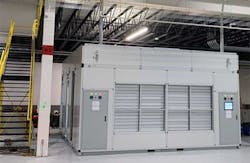NEW YORK – Jake Ring is passionate about bringing the benefits of the Internet’s hyperscale titans to a data center near you. Or at least closer to you.
Ring has founded two companies to offer colocation space based on modular data center designs. The latest expression of Ring’s vision for modular design is GIGA Data Centers, which seeks to bring hyperscale-style efficiency and economics to colocation customers.
“The main thing is that these (modular) systems deliver better cost, but also better energy efficiency,” said Ring, who spoke about the benefits of modular design at the recent DCD Enterprise conference in New York.
Ring is an industry veteran who worked in the Liebert business at Emerson and container-based infrastructure for GE. In 2014 he founded Atlanta-based DC Blox and served as CEO as the company built data centers in Chattanooga and Atlanta, with a vision of bringing affordable colocation facilities to second-tier markets. In 2017 he moved on to GIGA, which is also based in Atlanta.
GIGA is currently building its first data center in Mooresville, N.C. to offer colocation services using its WindChill modules. As the name implies, the design uses fresh air to cool servers, cooling it using an adiabatic cooling system in which air passes through water flowing through evaporative cooling media (similar to cardboard). The design uses negative air pressure to guide air through the servers and into a contained hot aisle, preventing the mixing of hot and cold air.
Ring says the WindChill design is proprietary, but it is similar in concept to the ITPAC modular design used by Microsoft from 2010-1014, which used media “air washers” to cool fresh air for its servers. Facebook has used evaporative media at a larger scale in several of its data center cooling systems.
“The result looks like an air handler, but the interior of the data center looks like any other you would see,” said Ring.
In seeking to adapt modular designs for the multi-tenant market, GIGA is following a path forged by IO Data Centers (now part of Iron Mountain) and BASELAYER, as well as the recent batch of edge computing startups including EdgeMicro, Vapor IO and DartPoints.
$5 Million A Megawatt?
GIGA combines its cooling systems with a power architecture using lithium-ion UPS systems, which Ring says will provide the best total cost of ownership (TCO). Advocates of lithium-ion batteries cite multiple advantages over lead-acid batteries, including a longer lifetime, reduced weight and footprint, and less rigid cooling requirements. This enables GIGA to operate at temperatures up to 90 degrees, which saves money by eliminating the need for air conditioners (CRACs) or air handlers.
A look inside a data hall within a GIGA Data Centers WindChill module. (Photo: GIGA)
The company uses a two-story data center design that places electrical equipment above the data modules, which saves money by allowing shorter cabling runs.
A key piece of GIGA’s economics is location, where it also tracks the hyperscale players. Mooresville is in western North Carolina, which offers a plentiful supply of affordable power. It’s not far from huge cloud data centers operated by Apple (Maiden), Google (Lenoir) and Facebook (Forest City).
The GIGA data center was previously used to build NASCAR race cars for the Dale Earnhardt team. It has an on-site substation connected to two Duke Energy power generation plants near Lake Norman, offering a plentiful supply of renewable hydro energy (another hyperscale priority).
When you combine all these attributes, the result is a data center that can operate with an extremely low Power Usage Effectiveness (PUE) energy efficiency rating of 1.15, and a deployment cost of just $5 million per megawatt, according to Ring. That suggests that GIGA can add capacity at about the same cost as hyperscale players with much larger operations.
Expanding the NC Colo Map
While Western North Carolina is a popular hyperscale market, its multi-tenant market is focused in Raleigh and Durham to the east, with a handful of providers (including Flexential and TierPoint) operating in Charlotte, about 30 miles south of the GIGA location.
“The hype about modular data centers started in 2011, but it turned out the market wasn’t ready for it at the time,” said Jabez Tan, Research Director at Structure Research, in comments to Channel Partners. “We’re reaching a point where business data requirements are getting more distributed and unique, so we are seeing more modular approaches.”
Ring sees potential in embracing the hyperscale designs of the Open Compute Project, an open source hardware movement founded by Facebook to create a design ecosystem for hyperscale computing. “We’re going to be one of the first data centers in North America to be certified OCP-ready,” Ring said.
Why GIGA? Firstly, it references the “giga” amplifier for data usage and storage. Ring is a person of faith, he told the audience at DCD, so it also serves as an acronym for “God is Great, Amen.”
About the Author


